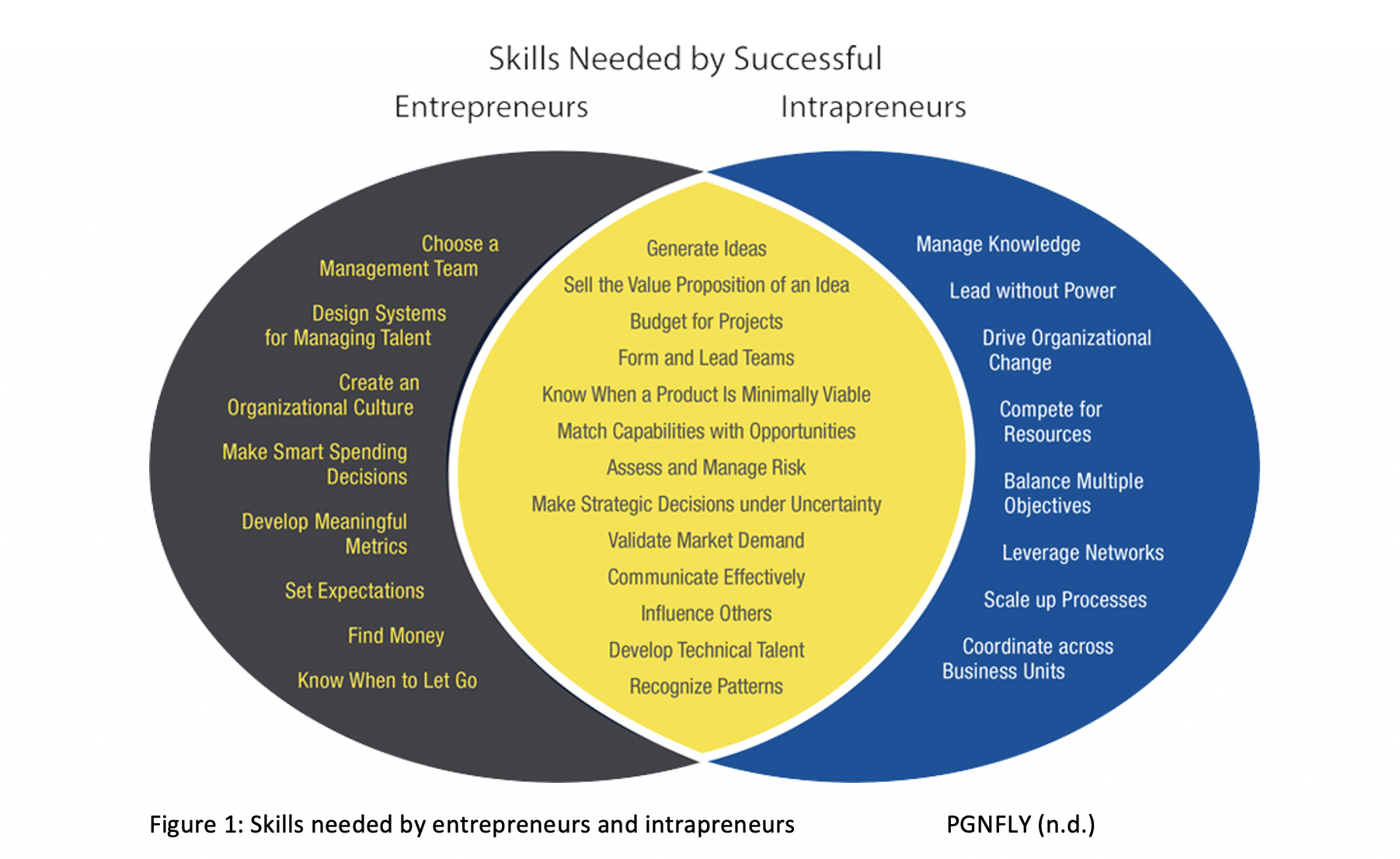What is yellow, sitting on most desks in over 100 countries and is sold over 50 billion times a year? It is a product that was made by an employee, that ended up on a shelf for over three years before being considered as a possible solution to a problem. What was that problem? Well, in 1974 Arthur Fry was singing in his choir and he had scraps of papers in his hymnal. By the end of the week all those pieces of paper were lost, and Fry was frustrated by this. But he remembered an adhesive that was accidentally developed by his fellow 3M colleague, Spencer Silver. He put the adhesive onto yellow scraps of paper that happened to be lying around so that he could hold bookmarks in his hymnal. This was when and how the Post-it-note was conceived.
The Post-it-Note is a classic example of intrapreneurship. Intrapreneurship is a term that was coined by Pinchot in the 1960’s who defined intrapreneurs as ‘dreamers who do’. I equate intrapreneurship to be like the little sister or brother of entrepreneurship. But what is entrepreneurship?
The concept of entrepreneurship has been around for centuries. The term ‘entrepreneurship’ was first written in 1730 by Richard Cantillon, an Irish French economist. In his Essai, Cantillon made the contribution of identifying the entrepreneur as a risk-bearer. Fast forward 200 years, a key influencer in the entrepreneurship discipline is Schumpeter (1934) who equated entrepreneurship with the concept of innovation applied to a business context. Schumpeter equated the entrepreneur to being an innovator who implements change within markets through the carrying out of new combinations. Numerous modern definitions of entrepreneurship are mostly a re-working and expansion of Schumpeter’s definition. Most modern definitions include a strong link between entrepreneurship and innovation and distinguish entrepreneurship from a simple form of management. Entrepreneurship is thus seen as the process of identifying, developing, and bringing forward new innovative ways of doing things for the exploitation of commercial opportunities. Many see entrepreneurship as a key contributor to economic growth in the 21st century.
As mentioned previously, the term intrapreneurship emerged in the 1960s and it is where employees think and act like entrepreneurs, but work in an already established organisation rather than their own business. To encourage intrapreneurship, an organisation needs to give their employees freedom and the financial support to create new products, services and systems and allow them to not follow the company’s usual routines or protocols.
Intrapreneurship is a behavior sought out by many employers and start-up businesses. Intrapreneurship particularly resonates with millennials. It is a mindset and series of behaviours that can be learnt which leads to the creation of a self-motivated, proactive, and action-oriented employee who takes the initiative to pursue and deliver an innovative product or service. Intrapreneurship is a win-win situation for both the employee and the business. It allows companies to be disruptive and develop new ways of doing business or new products or processes within the structure of the organisation.
Skills needed by successful entrepreneurs and intrapreneurs
There are both similarities and differences between intrapreneurs and entrepreneurs in terms of their skill set (see Figure 1). An overlap of their skill set is that both entrepreneurs and intrapreneurs must generate a viable business proposition that is satisfying a need in the marketplace. They must conduct market research and validate their proposition. They both need to lead and manage a team and be capable of communicating with various audiences. They both must deal with finance issues such as budgeting.

Therefore, intrapreneurs demonstrate their entrepreneurial orientation by the way they think and act. They have an entrepreneurial mind-set: they think differently, make decisions differently and act differently than more traditional employees. These attributes enable them to be effective in driving innovation and change from inside an established organisation. They are creating new paths, new ways of operating that are often foreign to many of their colleagues.
Is intrapreneurship common practice in organisations?
Intrapreneurship exists on a global scale. Richard Branson is a great advocate of intrapreneurship and he says that,
Virgin could never have grown into the group of more than 200 companies it is now, were it not for a steady stream of intrapreneurs who looked for and developed opportunities.
Steve Jobs equated the 1970s/80s Macintosh team as ‘intrapreneurs’ and saw them as a group of people going back to the garage but in a large company. Today, over 70% of most transformative innovations in the past 30 years has come from corporate employees i.e. intrapreneurs (Krippendorff cited by Eisenberg 2019).
In Australia, intrapreneurship is quite prevalent. According to the Global Entrepreneurship Monitor report for 2018, Australia is in the top 7 amongst 24 developed countries for entrepreneurial employee activity in established firms i.e. intrapreneurs are active in organisations. This then equates to some 1.2 million Australians. Thus an estimated 7.8% of the adult population in Australia is engaged in developing or launching new products, a new business unit or subsidiary for their employers.
Going back to Post-it-Notes, 3M have now embedded intrapreneurship into its DNA and it has subsequently developed more than 1,000 Post-It products. To conclude, intrapreneurship is a way to innovate like a start-up, while being as organised as a corporation. It positions employees and their creativity in the centre and transcends hierarchical organisations, being a bottom-up approach.
References:
Eisenberg, R (2019) Looking for purpose at work? Be an Intrapreneur, Forbes, online: https://www.forbes.com/sites/nextavenue/2019/12/17/looking-for-purpose-at-work-be-an-intrapreneur/#4f864a066a10, accessed 21st August 2020
PNGFLY (nd) Skills of an entrepreneur and an intrapreneur, online: https://www.pngfly.com/png-9kbmnr/download.html accessed 21st August 2020.

Associate Professor Naomi Birdthistle has entrepreneurship in her blood. She started her first business when she was in primary school and went on to work in her family business for over 20 years. She ran her own business for 10 years – Mind Your Own Business Ltd – which was a family business consulting firm. Naomi has studied in Scotland, Ireland and America. Her passion for entrepreneurship is evident by her research outputs, and she has published widely on the subject. Naomi examines disadvantaged groups and focuses on the disabled, refugees, and women in terms of entrepreneurial opportunities and training.
Professional Learning Hub
Our tailored professional learning focuses on the issues that are important to you and your team. Bringing together the expertise of Griffith University’s academics and research centres, our professional learning is designed to deliver creative solutions for the workplace of tomorrow. Whether you are looking for opportunities for yourself, or your team we have you covered.